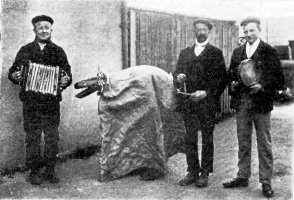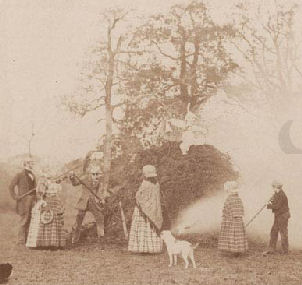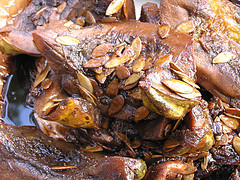|

November Celebrations
All Hallow's Eve/All Souls' Day
Samhain or All Hallow's Eve/Halloween (October 31) through All Soul's Day (November 2) until Mischief Night (November 4) and Bon Fire Night/Guy Fawkes Day (November 5) is the season of Hallowtide. Halloween and All Souls Day have their origins in Celtic myth. This season is considered a time when the veil between the mortal world and the Underworld is thinnest, communication with the dead possible, when souls who have died during that annual turn of the Wheel finally cross to the Summerland. People burn candles and bonfires to light the way to the afterlife. Sometimes the dead revisit their homes on All Souls' Night, so that candles light the way home. Gifts of food and wine are set out for the dead. Later, Christians adopted this festival of remembrance to offer prayers for the dead in return for money or food from their wealthier neighbors. People go a'souling, requesting alms or soul cakes -- the origin of modern caroling.
 All Souls' Day remembers all those who have died, not just the great and good, but ordinary folks as well. Families visit graves and flowers and greenery, and the names of the dead may be read from Christian pulpits on request. In some countries, All Souls' Day ends with songs or a play. All Souls' Day remembers all those who have died, not just the great and good, but ordinary folks as well. Families visit graves and flowers and greenery, and the names of the dead may be read from Christian pulpits on request. In some countries, All Souls' Day ends with songs or a play.
A soul, a soul, a soul cake
Please, good missus, a soul cake.
An apple, a pear, a plum or a cherry,
Any good thing to make us all merry.
The Soulers do around to villages singing this and other songs. Often, they are accompanied by a hobby horse character called a Hooden Horse.
Soul Cake Recipe
 A Soul Cake is similar to a hot cross bun but without the cross of icing on top or the currants or raisens. A Soul Cake is similar to a hot cross bun but without the cross of icing on top or the currants or raisens.
- 6 oz. butter
- 6 oz. caster sugar
- 3 egg yolks
- 1 lb. flour
- pinch of salt
- 1 tsp. ground allspice
- Warm milk
Preheat the oven to 360 degrees F (Gas 4)
Cream the butter and sugar together in a bowl until fluffy, then beat in the egg yolks. Sift the flour and spices, add to the egg/sugar mixture with enough warm milk to create a stiff dough. Knead thoroughly for 5 minutes. Roll out 1/4" thick; cut into 3" rounds and set on a greased baking sheet. Prick cakes with a fork and bake 20 - 25 minutes. Sprinkle lightly with powdered sugar.
Mischief Night
In some parts of Britain, November 4th is celebrated as Mischief Night. Pranks and tricks are played, with the main occupation placing things in the wrong places like out-houses errected overnight on rooftops, interesting hats and clothing placed on statues, etc. In northeast Derbyshire and south Yorkshire villages, children engage in custom called Jolly Minering, a varient of Penny for a Guy traditions to raise money for fireworks and sweets. It started as a way to acquire coal for a bonfire "to make the kettle sing." The alms song starts with:
We're three Jolly Miners,
And we're not worth a pin,
So give us a piece of coal
And we'll make the kettle sing.
Beaver's Moon - November 5 at 7:58 AM EST
Beavers are actively preparing for winter, so prior to the freezing of the lowlands and shallow rivers, fur trappers set out beaver traps.
Bon Fire Night/Guy Fawkes Day
 Guy Fawkes Day and its accompanying Bon Fire Night are celebrated across Britain on November 5th. The day was declared a holiday by decree of Parliament following int unsuccessful attempt by Guy Fawkes and the Gunpowdered Plot in 1605 to blow up the Houses of Parliament. All parish churches were required, until 1859, to hold services on this day. Bells have rung out, cannons fired, and kegs of beer have been drained in over 400 years of this relatively modern celebration. Originally Guy Fawkes was burned in effigy. Later the effigies of the Pope and other despised figures appeared atop the bonfires with great displays of fireworks. Guy Fawkes Day and its accompanying Bon Fire Night are celebrated across Britain on November 5th. The day was declared a holiday by decree of Parliament following int unsuccessful attempt by Guy Fawkes and the Gunpowdered Plot in 1605 to blow up the Houses of Parliament. All parish churches were required, until 1859, to hold services on this day. Bells have rung out, cannons fired, and kegs of beer have been drained in over 400 years of this relatively modern celebration. Originally Guy Fawkes was burned in effigy. Later the effigies of the Pope and other despised figures appeared atop the bonfires with great displays of fireworks.
The start of the new Lord Mayor's year in office is celebrated in London on the second Saturday in November. Since the first Lord Mayor's Show in 1215, only the Black Death and the Duke of Wellington's funeral have interrupted this event.
Armistice Day
On November 11th, the soldiers who perished in two World Wars are remembered.
St. Martin's Day
November 11th is also the the celebration of St. Martin's Day, Martinmas. Hiring fairs took place on this date, with farm laborers seeking positions. In the south of Derbyshire, a Cakes & Ale Festival celebrated the completion of the autumn wheat seedling. The custom is for the farmers to provide special Hopper Cakes made of seed and grain. Beef dishes and "beverages of grain" are enjoyed in great amounts, too. St. Martin, the groundhog of Britain, inspired weather superstition that if the wind is in the south-west on his day, the climate will stay warm through until Candlemas on the first of February, ensuring a mild and snowfree winter.
"Wind north-west at Martinmas, severe winter to come."
If ducks and geese do slide at Martinmas
At Christmas they will swim
If geese and ducks do swim at Martinmas
At Christmas they will slide.
Ice before Martinmas,
Enough to bear a duck
The rest of winter
Is sure to be but muck!
"Thunder in November means winter will be late in coming and going."
"If the leaves of the trees and grape vines do not fall before Martin's Day, a cold winter may be expected."
"A warm November is the sign of a bad Winter."
Flowers bloomin' in late Autumn
A sure sign of a bad Winter comin'.
"As high as the weeds grow,
So will the bank of snow."
St. Cecilia's Day
St. Cecelia, is believed to have been a Roman maiden martyred sometime between 200 - 200 AD. Her story is told in Chaucer's "Second Nun's Tale" of The Canterbury Tales. The patron saint of musicians, St. Cecelia's symbol is the organ, and recitals and concerts are enjoyed on her day.
St. Andrew's Day
The patron saint of Scotland is celebrated on November 30th.
Mexican Candied Pumpkin — Calabaza En Tacha
 Followng Los Dias de Los Muertos (The Days of the Dead) in October, the pumpkins that decorated the family altars are turned into a candied vegetable dish perfect to enjoy during fall harvest. Followng Los Dias de Los Muertos (The Days of the Dead) in October, the pumpkins that decorated the family altars are turned into a candied vegetable dish perfect to enjoy during fall harvest.
- 5 lb. pumkpin
- 4 sticks of cinnamon
- 1 orange, juiced and zested
- 2 lb. piloncillo OR 1 3/4 cups of dark brown sugar and 1/4 cup molasses
- 4 cups water
Cut off the stem of the pumpkin and discard. Split the pumpkin; scape out the pumpkin guts and seeds, saving the seeds for roasting later. Cut each half of the pumpkin into 8 - 10 lengthwise strips. Remove the skins from each piece, and cut the pumpkin into 1 - 2 inch pieces. Place into a large saucepan along with the piloncillo, orange juice, zest, cinnamon sticks and water and bring all to a boil. Carefully add the piloncillo pieces, and reduce to a slow simmer for about 2 hours until the pumpkin is tender and the rest of the ingredients have been reduced to a thick glaze. Remove from the heat and cool.
Return to Mythic Passages Menu
Subscribe to the Mythic Passages e-magazine
|

